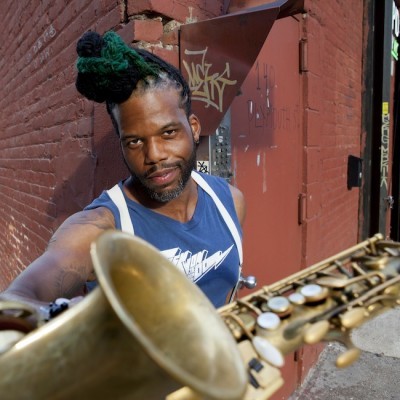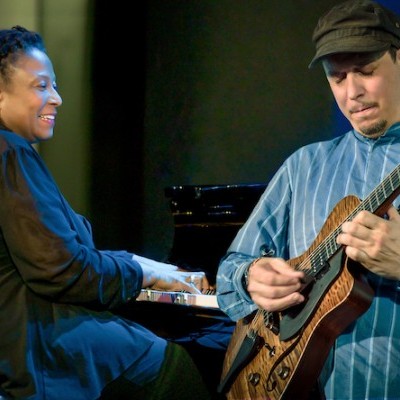Apr 2, 2024 12:59 PM
Saxophonist, Sonic Explorer Casey Benjamin Dies at 45
Casey Benjamin, the alto saxophonist, vocalist, keyboardist and producer who stamped his distinctive sounds on the…
Palermo’s namesake big band has earned a reputation as a virtual circus of jazz-rock medleys, mashups, jump-cuts and other spirited musical mischief.
Rightly so. For more than 25 years, the alto saxophonist and arranger has led his 17-piece, New York-based ensemble with humor, wit and a passion for repertoire that extends far beyond the big band canon.
“Medleys and mashups—that’s my thing,” Palermo said during a mid-November phone call from his home in West Orange, New Jersey. Prior to the pandemic, the Ed Palermo Big Band had been playing once a month at Iridium in Manhattan, and every other month at The Falcon in Marlboro, New York. Since becoming famous for its Frank Zappa tribute shows at The Bitter End starting in 1994, the group has accumulated a vast book of madcap arrangements that incorporate everything from Zappa’s infamously quirky pieces to classic jazz compositions and Palermo’s own originals.
Palermo also has charted hundreds of songs by British rock bands, many of which appear on the double album The Great Un-American Songbook Volumes 1 & 2 (Cuneiform, 2017). His new release, The Great Un-American Songbook Volume 3: Run For Your Life (SkyCat), focuses mainly on songs by The Beatles, whose music, like Zappa’s, helped shape Palermo’s eclectic tastes early on.
These days, Palermo, 66, is content to be working as an educator, first and foremost. He teaches at Jazz House Kids in Montclair, New Jersey, and Hoff-Barthelson Music School in Scarsdale, New York, in addition to giving private lessons via Zoom and FaceTime. But his love for reinterpreting songs by his heroes continues to fuel his restlessly creative spirit.
“Ed has boundless energy and an unbelievably creative mind,” said Matt Ingman, who has played bass trombone and tuba in Palermo’s big band for 22 years. “He’s like a mad scientist, putting the most unlikely tunes together to create some absolutely brilliant mashups.”
“Ed loves being the center of attention and is forever trying to make us and his audience laugh,” said bassist Paul Adamy, who’s been with the ensemble since 1994. “Ed once went as far as completely shaving his head to get into character [as the supervillain Ernst Stavro Blofeld] for a James Bond-themed show.”
“I think my presence in the band has served as an enabler for Ed’s weirder side in our live performances,” said Bruce McDaniel, who has played guitar and sung with the band for 15 years. “Giving him somebody to play off as either straight man or fool has opened up a can of worms that can’t be closed. This era of Ed’s band began as a way for him to open people’s eyes to the hidden beauty in so much of Zappa’s music by recontextualizing it. But it has shifted into much more of a window into Ed’s mind, which is a cluttered, random, bizarre locale, but an interesting place to visit.”
“Playing Ed’s arrangement of ‘Come Together’ is what I imagine it must be like to step into his brain for a minute,” said violinist Katie Jacoby, who joined the band in 2010. “There’s so much going on simultaneously, and it all fits together perfectly like a puzzle.”
Conversing with Palermo is like embarking on a long, exhilarating adventure through the interconnecting back alleys of his mind, as he casually pinballs from one topic to the next and back again. The following interview has been edited, reshuffled, pitch-corrected, torn apart and stitched back together for the sake of length, clarity and everyone’s sanity.
Walk us through the process of crafting a good mashup.
I think everyone has that particular syndrome where one song reminds them of another. Then, what I do is, instead of ignoring it, and seeing it as a nuisance or an oddity, I run with it. And I work up a mashup of it. It’s not just to be clever, and not just to surprise audiences, even though that’s a big, fun factor of it. Ultimately, it can become bigger than the sum of its parts.
On The Great American Songbook Volumes 1 & 2, we do the Beatles’ “Don’t Bother Me.” And while I was arranging that, Miles Davis’ “Nardis” came to mind. So, on that album I have a medley of “Don’t Bother Me” plus “Nardis.” And that was strictly that melodic line, plus the fact that it’s in a minor key.
Another example would be from the new album, where I mash up the Beatles’ “Fixing A Hole” with Frank Zappa’s “Let’s Move To Cleveland.” I don’t remember exactly what made me think that one would work with the other, but as I was arranging the two, and I was getting really into the arrangement—particularly towards the end where it just keeps building and building and layering the melodies on top of each other—I realized I’d got into something pretty big, pretty epic. And so, what I’m trying to get at here is to make that mashup greater than the sum of its parts. As I arranged, I knew I was onto something. We performed that mashup for more than a year before we ever recorded it. Every time we did it live, something magnificent was happening.
Other songs on the new album fit that description, like our mashup of Zappa’s “Moggio” and the Moody Blues’ “Nights In White Satin.” I’ve always wanted to do “Nights In White Satin,” but I didn’t want to do it just like the Moody Blues, because they already have the definitive version. It’s one of my favorite songs, ever since I was in high school. So, just messing around on the piano and playing the chords of “Moggio,” I heard the melody of “Nights In White Satin” in my head.
When we were rehearsing the “Nights In White Satin” and “Moggio” thing, I remember looking at the musicians and thinking, “I can’t believe how this is making me feel.” I mean, when you have a band of tremendous musicians who are taking an arranger’s idea and making it work on epic levels, it is the most gratifying thing there is in life.
I couldn’t help but notice on your arrangement of The Moody Blues’ “Nights In White Satin” that the person doing the spoken-word part (“Breathe deep the gathering gloom …”) took some liberties with the words and added some snide asides.
In real life, his name is Jim Mola, and he’s a great drummer, singer and voiceover actor. And he has an alter-ego by the name of Mike James. When he’s in character, he wears a fat suit and puts on a really bad toupee, and he is basically a Frank Sinatra wannabe. And a long time ago I thought, “We’ve got to work that into the act.” So, he’s been on several of our albums in a humorous context. My first idea for the “Nights In White Satin” recitation wasn’t Mike James. It was Gilbert Gottfried [imitates the comedian’s nasal voice]. I thought that’d be so funny. But I couldn’t reach him. I tried.
Then I said, “Well, Mike James will be great for that.” It’s a perfect example of what my band is about, how we don’t take ourselves so seriously. Our live shows are filled with self-deprecation, and political humor, too. We’re not about to let the last four years get by without constant ridicule. Some of it’s spontaneous, and most of it is in the music itself. Every live show we do is not only different musically, but it has a different, funny theme.
In addition to covering The Beatles and other British Invasion bands extensively, your group has performed and recorded a ridiculous number of Frank Zappa tunes. Talk about how Zappa’s music has influenced you.
Frank Zappa was known—and rightfully so—for being hysterically funny. And he put it in his music. He even has an album called Does Humor Belong In Music? Now, of course, my answer to that is, why wouldn’t it? All music is just a reflection or celebration of life. But that’s not everyone’s thing. So, it’s my thing. But what surprises some people is that my humor is totally different than Frank’s. Zappa’s humor was very rarely self-deprecating, and mine is almost always self-deprecating. The beauty of it is that no one gets hurt.
When I saw Zappa for the first time in 1969, in Philadelphia, I was in ninth grade, and it changed my life. He’d be playing some song, he’d put his hand up and boom, on a dime, the band would go into something totally different. That type of thing has a comedic element, but also it’s exciting. You know, “How did you do that?” So, I would say that the “anything goes” concept was 100% influenced by Frank Zappa.
Let’s get back to The Beatles. How does one translate their brand of ’60s British pop-rock into a big band arrangement?
One of the first Beatles songs that I arranged years ago, prior to doing any Frank Zappa arrangements, was “I Wanna Be Your Man.” Now, right off the bat, the melody as written is somewhat syncopated. So that helps, right? And it’s a relatively simple chord progression.
Once you have something like that, and you’re not encumbered by the harmony, you’re thinking more of the melodic line. So, what I did in that situation was I played off the melody and had other syncopated lines on top of the Beatles’ original melody. Now, as an arranger, you can make your own chords, which I did a little bit of in my first arrangement of “I Wanna Be Your Man.” But you have to watch out for that. And this is where it becomes very subjective. Once you start adding fancy-pants chords to a song that you love as it is, then you run the risk of condescending to the song. I never want to do that.
So, if you’re applying Beatles music to a big band, one way to do it is to have a song that’s mainly melody and groove, and add cool melodic counter lines.
What about a more complex Beatles song like “Strawberry Fields Forever,” which appears on the new album?
Once again, I didn’t want to condescend and add a bunch of B.S., because I thought the harmony was perfect as it is. I stayed true to the harmony. But then I decided that I was going to segue into the Frank Zappa song “Shove It Right In.” Just to give you an indication about how interchangeable my whole concept is: “Shove It Right In” used to be part of a medley with “Let’s Move To Cleveland.” But on the new album, “Let’s Move To Cleveland” is hooked up with the Beatles’ “Fixing A Hole.” So, these are all really interchangeable, which is another concept I got from Frank Zappa. Zappa saw his whole body of work as one piece. And you could take one bit of that and put it anywhere else. He had a name for it.
Do you mean “modular”?
Yes, exactly. The part of his concept that I completely embrace is where you take every thing that you do, and you can plug it in somewhere else. If I’m noted for anything, among people who follow my music, it’s that.
One of my favorite parts of my “Strawberry Fields” arrangement is, at some point, the bass starts playing a line that goes [vocalizes a funky vamp]. Now, most people won’t get that, but that’s Jimi Hendrix’s “Little Miss Lover.” There’s a lot of things like that. In my “Nights In White Satin” arrangement, for several bars, I throw in the bass line to “Whipping Post” by the Allman Brothers Band. A lot of these things aren’t necessarily caught by the audience. Now, I do have some fans who hear everything, but you don’t have to recognize every thing that I came up with to enjoy it.
Who are these so-called “fans” you speak of?
It’s not your typical jazz audience. There are jazz enthusiasts in the audience, and it is still primarily a jazz big band. We’re always breaking into some, usually fast, jazz things. We play a lot of jazz, but I wouldn’t say that we have the same audience as the Village Vanguard. A lot of my audience, they love Maria Schneider, as do I. Her music is as good as it gets. But the thing that my fans really like is the fact that we do so many songs. And none of my songs are ever more than three minutes long before I go into something else.
When I first started the band, I used to write these long, epic things like Maria does. But one thing I’ve realized is that over the years, my passion for music has only grown, but my attention span is short. And how I set up my shows is a reflection of that.
The way I think about it: Seinfeld was made up of these really tiny scenes. And then, the genius was how it made for this hilarious and unpredictable convergence at the end. That’s exactly how I see what I do, both in live performance and on the new album. It’s like one long suite, but the thing that we end with will always have something to do with how we started.
Do you get satisfaction from your creative endeavors?
If I was ever going to write a book, the theme would be: “How to be a happy musician without being famous.” Because, you can be. I am proof that it’s possible, as long as you resign yourself to the fact that you’re not gonna be doing it for a living. Life is short, and we’re learning that now more than ever. So, I’m going to have as much fun as possible. And it has nothing to do with trying to become famous.
I’m blessed I can teach and make a living that way. My wife and I are both on Medicare and Social Security now—we’re both old enough that I don’t have to try to pretend to be anything. And I get to play different music all of the time. This is the life. DB
This story originally was published in the February 2021 issue of DownBeat. Subscribe here.

Benjamin possessed a fluid, round sound on the alto saxophone, and he was often most recognizable by the layers of electronic effects that he put onto the instrument.
Apr 2, 2024 12:59 PM
Casey Benjamin, the alto saxophonist, vocalist, keyboardist and producer who stamped his distinctive sounds on the…

“He’s constructing intelligent musical sentences that connect seamlessly, which is the most important part of linear playing,” Charles McPherson said of alto saxophonist Sonny Red.
Feb 27, 2024 1:40 PM
“I might not have felt this way 30 to 40 years ago, but I’ve reached a point where I can hear value in what people…

Albert “Tootie” Heath (1935–2024) followed in the tradition of drummer Kenny Clarke, his idol.
Apr 5, 2024 10:28 AM
Albert “Tootie” Heath, a drummer of impeccable taste and time who was the youngest of three jazz-legend brothers…

“Both of us are quite grounded in the craft, the tradition and the harmonic sense,” Rosenwinkel said of his experience playing with Allen. “Yet I felt we shared something mystical as well.”
Mar 12, 2024 11:42 AM
“There are a few musicians you hear where, as somebody once said, the molecules in the room change. Geri was one of…

Henry Threadgill performs with Zooid at Big Ears in Knoxville, Tennessee.
Apr 9, 2024 11:30 AM
Big Ears, the annual four-day music celebration that first took place in 2009 in Knoxville, Tennessee, could well be…